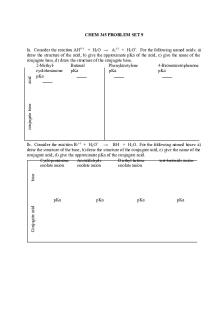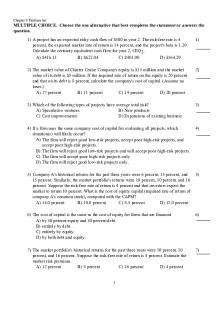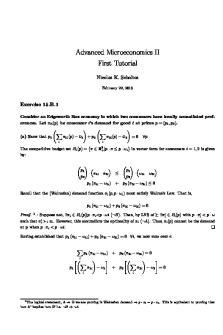Microeconomics Problem Set 9 answer PDF

| Title | Microeconomics Problem Set 9 answer |
|---|---|
| Author | Bing LAN |
| Course | Microeconomics |
| Institution | 香港科技大學 |
| Pages | 5 |
| File Size | 275.8 KB |
| File Type | |
| Total Downloads | 45 |
| Total Views | 178 |
Summary
Microeconomics Problem Set 9 answer
about microeconomics
some answers...
Description
Problems and Applications 3. A commercial fisherman notices the following relationship between hours spent fishing and the quantity of fish caught: (figure) a. What is the marginal product of each hour spent fishing? This table shows the marginal product of each hour spent fishing:
b. Use these data to graph the fisherman’s production function. Explain its shape.
The production function gets flatter as the number of hours spent increases, reflecting diminishing marginal product. c. The fisherman has a fixed cost of $10 (his pole). The opportunity cost of his time is $5 per hour. Graph the fisherman’s total cost curve. Explain its shape.
The total cost curve gets steeper as the quantity of output increases because of diminishing marginal product. 4. Nimbus, Inc., makes brooms and then sells them door-to-door. Here is the
relationship between the number of workers and Nimbus’s output during a given day: (figure) a. Fill in the column of marginal products. What pattern do you see? How might you explain it?
The marginal product initially increases till 3 units of worker and then starts to decrease. It might be because the production space is not yet saturated and the increase in workers has led to increased efficiency. Higher production levels allow specialization among workers, which permits each worker to become better at a specific task. Therefore, the marginal product initially increases. When there are 3 workers, as the number of workers increases, additional workers have to share equipment and work in more crowded conditions. Eventually, the workspace becomes so over-crowded that workers often get in each other’s way. Hence, as more workers are hired, each extra worker contributes fewer additional brooms to total production. b. The answers have been filled in the table above. c. Fill in the column for average total cost. What pattern do you see? ATC initially decreases and after 5 unit of worker it starts to rise. The pattern of ATC is U-shaped. d. Now fill in the column for marginal cost. What pattern do you see? MC initially decreases and after 3 unit of worker it starts to rise. The pattern of MC is U-shaped. e. Compare the column for marginal product with the column for marginal cost.
Explain the relationship. Before hiring 3 workers, the marginal product increases while the marginal cost decreases. After hiring 3 workers, the marginal product decreases while the marginal cost increases. It can be attributed to the law of diminishing returns. When initially adding a new worker, he helps to increase the output and even the marginal product therefore the marginal cost decreases because of the same amount of increase in total cost. But after too many workers have been added, workers may find themselves wasting time waiting to use equipment, or simply crowding one another out, which decreases their efficiency producing less per person and then results in a higher marginal cost. f. Compare the column for average total cost with the column for marginal cost. Explain the relationship. When the average total cost declines, the marginal cost is less than the average cost. When the average total cost increases, the marginal cost is greater than the average cost. the marginal cost curve crosses the average total cost curve at the minimum of average total cost. It is because at low levels of output, marginal cost is below average total cost, so average total cost is falling. But after the two curves cross, marginal cost rises above average total cost. 5. You are the chief financial officer for a firm that sells gaming consoles. Your firm has the following average total cost schedule: (figure). Your current level of production is 600 consoles, all of which have been sold. Someone calls, desperate to buy one of your consoles. The caller offers you $550 for it. Should you accept the offer? Why or why not? When produce an extra gaming console, the cost equals to (601 ×301600×300)=901, which is higher than the price that the caller offers. Therefore, I won’t accept the offer. 7. Your cousin Vinnie owns a painting company with fixed costs of $200 and the following schedule for variable costs. Calculate average fixed cost, average variable cost, and average total cost for each quantity. What is the efficient scale of the painting company?
The efficient scale of painting company is 4 houses per month because it holds the least average total cost. 8. The city government is considering two tax proposals: A lump-sum tax of $300 on each producer of hamburgers. A tax of $1 per burger, paid by producers of hamburgers. a. Which of the following curves—average fixed cost, average variable cost, average total cost, and marginal cost—would shift as a result of the lump-sum tax? Why? Show this in a graph. Label the graph as precisely as possible.
The average fixed cost curve and the average total cost curve would shift because the lump-sum tax increases the fixed cost but has no effect on marginal cost and variable cost. Therefore, fixed cost curve and the average total cost curve would shift upward. b. Which of these same four curves would shift as a result of the per-burger tax? Why? Show this in a new graph. Label the graph as precisely as possible.
The average variable cost curve, average total cost curve and marginal cost curve would shift because the per-burger tax increases the variable cost per unit produced but has no effect on fixed cost. Therefore, these three curves would shift upward.
9. Jane’s Juice Bar has the following cost schedules (table) a. Calculate average variable cost, average total cost, and marginal cost for each quantity.
b. Graph all three curves. What is the relationship between the marginal cost curve and the average total cost curve? Between the marginal cost curve and the average variable cost curve? Explain.
When the average total cost declines, the marginal cost is less than the average cost. When the average total cost increases, the marginal cost is greater than the average cost. the marginal cost curve crosses the average total cost curve at the minimum of average total cost. It is because at low levels of output, marginal cost is below average total cost, so average total cost is falling. But after the two curves cross, marginal cost rises above average total cost. As for average variable cost, it always less than marginal cost. The difference between this two is the increase in variable cost per unit of product....
Similar Free PDFs

Microeconomics Problem Set 10
- 6 Pages

Problem Set 01 Answer
- 5 Pages

Problem set 3 Answer
- 14 Pages

Problem set 9 - Questions
- 3 Pages

Problem Set 9 (Answers)
- 12 Pages

Problem set 9 sheet
- 2 Pages

Problem Set 9-Solutions
- 6 Pages

Chapter 9 Problem Set
- 6 Pages

Problem Set 2 Answer Key New 2
- 7 Pages

Lab Problem Set #2 answer key
- 3 Pages
Popular Institutions
- Tinajero National High School - Annex
- Politeknik Caltex Riau
- Yokohama City University
- SGT University
- University of Al-Qadisiyah
- Divine Word College of Vigan
- Techniek College Rotterdam
- Universidade de Santiago
- Universiti Teknologi MARA Cawangan Johor Kampus Pasir Gudang
- Poltekkes Kemenkes Yogyakarta
- Baguio City National High School
- Colegio san marcos
- preparatoria uno
- Centro de Bachillerato Tecnológico Industrial y de Servicios No. 107
- Dalian Maritime University
- Quang Trung Secondary School
- Colegio Tecnológico en Informática
- Corporación Regional de Educación Superior
- Grupo CEDVA
- Dar Al Uloom University
- Centro de Estudios Preuniversitarios de la Universidad Nacional de Ingeniería
- 上智大学
- Aakash International School, Nuna Majara
- San Felipe Neri Catholic School
- Kang Chiao International School - New Taipei City
- Misamis Occidental National High School
- Institución Educativa Escuela Normal Juan Ladrilleros
- Kolehiyo ng Pantukan
- Batanes State College
- Instituto Continental
- Sekolah Menengah Kejuruan Kesehatan Kaltara (Tarakan)
- Colegio de La Inmaculada Concepcion - Cebu





